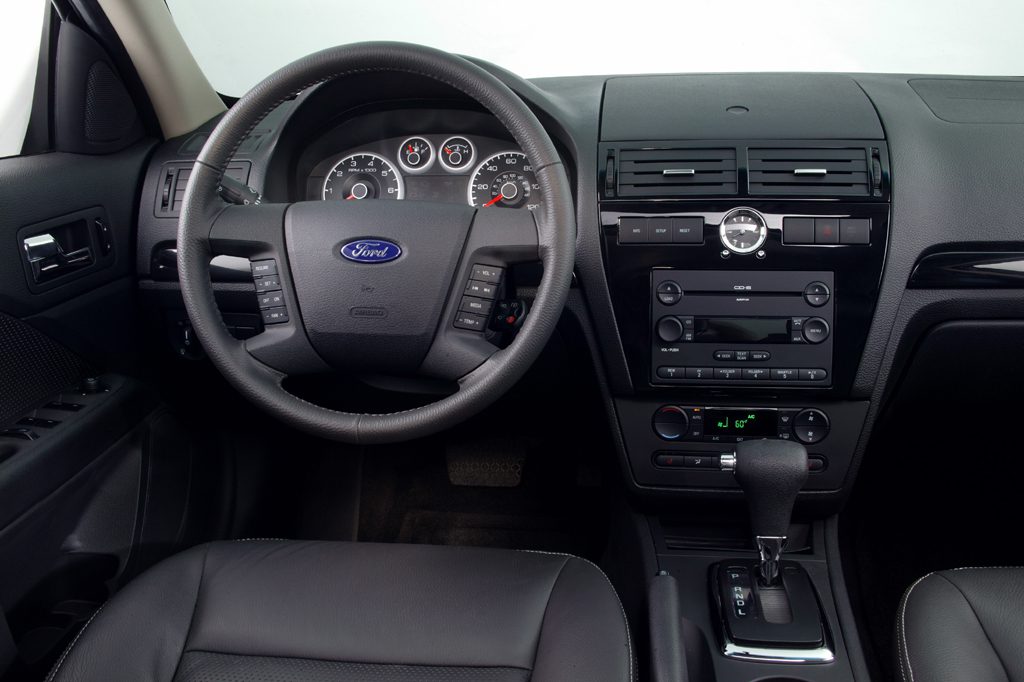| Midsize car; Built in Mexico |
|
|
| Good condition price range: $6,400 – $25,700* |

2008 Ford Fusion

2008 Ford Fusion

2008 Ford Fusion

2008 Ford Fusion
| Pros: |
|
| Cons: |
|
Fusion and its Milan near-twin target the Honda Accord and Toyota Camry, matching those perennial Best Buys in space and interior design. Road manners leave little to be desired, though engine refinement does not match that of the class leaders. New-car pricing has been a strong suit, too-even after adding antilock brakes and head-protecting curtain side airbags, safety options we highly recommend. Used-car valuations are another story, of course. Availability of AWD also appeals, as does the thrifty Hybrid model. Note that there’s no substantive difference between Fusion and Milan, though the latter has richer-looking interior appointments.
Overview
Brand-new for 2006, the four-door Fusion took over for the aging Taurus as Ford’s midsize sedan. Fusion shared its basic architecture with the more-upscale Mercury Milan and the Lincoln Zephyr (later renamed MKZ), a premium midsize car. Three trim levels were offered: S, SE, and top-line SEL. The S sedan held a 160-horsepower four-cylinder engine. SE and SEL models could have the four-cylinder or a 221-hp V6. The four-cylinder came with a five-speed manual transmission or optional five-speed automatic; the V6 with a six-speed automatic. Positioned between the compact Focus and “flagship” Five Hundred, all 2006 Fusion sedans had front-wheel drive.
Ford said the Fusion’s design was inspired by the 427 Concept seen at auto shows. Three distinct interiors were offered. Available features included a tilt/telescopic steering wheel, heated front seats, and a six-CD changer that served as an MP3 player.
Antilock four-wheel disc brakes were optional. So was a safety package with front torso and head-protecting curtain side airbags. Traction control was available for V6 models. S and SE models rode on 16-inch wheels, versus 17-inch for SELs. A sunroof and leather upholstery were optional for SE and SEL models. Fusion, Milan, and Zephyr were based on the Mazda 6 from Ford’s Japanese affiliate, but were slightly larger and lacked the 6’s hatchback and wagon body styles. Rivals included the Honda Accord, Nissan Altima, and Toyota Camry.
Yearly Updates
| 2007 Fusion For 2007, SE and SEL models could have all-wheel drive rather than the standard front-wheel drive. Seat-mounted airbags and curtain airbags became standard on all models, and Sirius satellite radio was available. So was Ford’s navigation system. SE/SEL models added a fold-down passenger seat. |
| 2008 Fusion Several new features were available for 2008, including rear-obstacle detection. Ford’s newly available and heavily promoted Sync feature was a voice-activated system for controlling cell phones and MP3 players. All Fusions now had antilock braking and a tire-pressure monitor. A new Sport Appearance Package was optional. |
| 2009 Fusion The 2009 Ford Fusion lineup now offered an antiskid system as an available safety feature. Otherwise, this midsize sedan was largely unchanged. |
| 2010 Fusion The 2010 Ford Fusion received more power and freshened styling. Also making its debut was the Fusion Sport and a gas/electric hybrid model. A 175-horsepower 2.5-liter 4-cylinder replaced the 160-horsepower 2.3-liter 4-cylinder. A 240-horsepower 3.0-liter V6 engine replaced the 221-horsepower 3.0 V6. New in the Sport was a 263-horsepower 3.5-liter V6. Powering the Hybrid was a 2.5-liter four and an electric motor with a combined 191 horsepower. |
| 2011 Fusion The 2011 Ford Fusion was largely unchanged following its freshening for the 2010 model year. |
| 2012 Fusion There were no changes of note to the 2012 Ford Fusion, though the six-speed manual transmission was no longer offered on the SE model. |
